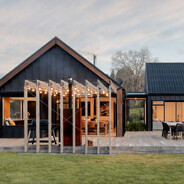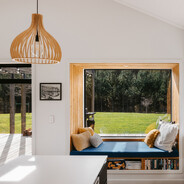Choosing colours for your new house design is one of the most exciting and crucial aspects of the entire building process. The colours you choose will set the tone for your home, influencing not only its aesthetic appeal but also the overall atmosphere, energy efficiency, and even your emotional well-being. Whether you're constructing a modern minimalist retreat or a traditional family home, colour plays a central role in determining how your home will feel and how it will interact with its environment.
This blog will provide you with comprehensive guidance on how to choose colours for your new house design. From understanding the psychological effects of colour to blending hues that complement your architectural style and surroundings, we will explore the best ways to pick the perfect colours for your home’s exterior and interior.
1. The Power of Colour in Home DesignThe Psychological Impact of Colour
Before you start selecting colours, it's important to understand that colour has a significant psychological impact on how spaces feel. Different hues evoke specific emotions and can influence mood, productivity, and even how we perceive space. Here are a few examples of how colour affects our emotions:
Warm Colours: Red, orange, and yellow are associated with energy, warmth, and stimulation. They are ideal for living rooms, kitchens, and dining areas, where social interaction and activity take place. These colours promote enthusiasm and creativity but should be used thoughtfully in spaces where relaxation is also desired.
Cool Colours: Blue, green, and purple create calming and relaxing atmospheres. These are perfect for bedrooms, bathrooms, and any space where you seek peace and tranquillity. These colours have the ability to reduce stress, helping you unwind after a busy day.
Neutral Colours: White, beige, grey, and taupe are versatile, timeless, and can create a sense of balance and sophistication. Neutrals serve as a backdrop for other colours and help balance more vibrant hues. They’re ideal in places where you want to create a calm, understated environment.
Understanding the psychological effects of colour allows you to make informed decisions about which hues are best suited for each room or exterior element. This knowledge ensures you choose colours that not only look beautiful but also contribute positively to your daily life.
Colour and Light
The amount of natural light a room receives can also drastically affect how colours appear. In spaces with abundant natural light, bold colours can appear vibrant and bright, while in rooms with less natural light, darker colours can make the space feel cosy or even a little too dark. Keep this in mind when choosing colours for areas of your home that have varying lighting conditions.
Moreover, artificial lighting also plays a key role in how colours appear. Incandescent light has a warm, yellowish tone, which enhances warm colours, while LED lights may emit cooler blue tones, affecting how colours like reds and oranges look. Pay attention to the lighting in each room before finalising your colour scheme to ensure your chosen colours look just as good day and night.
Colour and Space Perception
Colours can also influence how spacious or cosy a room feels. Light colours tend to open up a space and make it appear larger, while dark colours create a more intimate feeling. If you're working with a smaller room, consider using light, airy colours to create the illusion of space. In larger, more expansive areas, deeper tones can help add warmth and make the room feel more inviting.
A common technique in smaller rooms is to use light colours on the walls and ceilings while incorporating darker tones in accents like furniture and décor. This method gives the room a sense of openness without making it feel bare or cold and allows for colour to be easily updated as trends change.
2. Steps to Choosing Exterior Colours for Your House
The exterior of your house is the first thing people see, so the colours you select for the outside will set the tone for the entire property. Here’s how to choose the perfect colours for your house exterior.
Step 1: Consider the Architectural Style
The architectural style of your home will play a big role in your colour choices. Certain architectural styles lend themselves better to specific colour schemes:
Modern or Contemporary Homes: These homes often use neutral colours like white, grey, or black, paired with natural finishes like wood or concrete. Accents in bold colours like navy, emerald, or mustard can add character and interest if a bolder colour is desired.
Traditional or Colonial Homes: These homes typically feature muted, classic shades like beige, cream, or soft greens and blues. They often incorporate white or dark trim to provide contrast and a timeless look.
Cottage or Rustic Homes: Homes in a country or rustic style often use earthy tones like browns, taupes, and warm greens to blend into natural surroundings. These colours help create a warm, inviting exterior that feels part of the landscape.
Mediterranean or Spanish Revival: Warm terracotta, earthy reds, and deep blues are common, paired with white or off-white to reflect the bright Mediterranean sun. These colours help create a relaxed, vacation-like vibe.
By aligning your colours with the home’s architectural style, you create a cohesive and balanced design. This alignment helps your home blend seamlessly with the surroundings and stand out for the right reasons.
Step 2: Assess Your Surroundings
The natural environment surrounding your home is another key consideration when selecting exterior colours. For example, a coastal home might benefit from soft blues, whites, and sand tones to blend seamlessly with the sea and sky. A home in a forested area may look beautiful with earthy greens and browns that echo the natural landscape, while a home near the mountains might feature cooler tones or stone accents to reflect its rugged environment.
If your home is in an urban environment, consider colours that complement the cityscape. Neutral shades like grey or charcoal paired with natural materials like wood or stone can help your house stand out without clashing with its surroundings.
Step 3: Choose a Colour Palette for the Exterior
Once you’ve taken your home’s architectural style and environment into account, it’s time to select a colour palette. Exterior colour palettes typically consist of three main components:
Primary Colour: This is the dominant colour for the majority of your exterior. For example, this might be the cladding or main facade of your home. This is where you’ll invest the most effort to get the right tone and feel.
Trim Colour: The trim adds contrast and definition to the overall look of the home. Trim is typically used on windows, doors, gutters, and corners. Popular trim colours include white, black, and grey. Darker trim colours can help highlight architectural details, while lighter trim can provide a soft, classic look.
Accent Colours/Textures: Accent colours and textures are used sparingly, usually on architectural details and create focal points and draw attention to specific features.
Ensure that your colours complement each other and work harmoniously with the materials you’ve chosen. Keep in mind that too many contrasting colours can overwhelm the design, while too few can create a monotonous or dull appearance.
Step 4: Test Colours in Natural Light
Colours can appear quite different depending on the time of day and the amount of natural light they receive. Before committing to a colour scheme for your exterior, always test samples on a small section of your home’s facade and observe them at different times of the day. This will help you avoid surprises when the entire house is painted, as colours can appear warmer or cooler depending on the natural light and time of day. It’s worthwhile booking a consultation with a colour specialist to understand colours and how their base tones can affect the colour output. Resene and Dulux both offer this service.
Step 5: Think About Durability and Maintenance
Exterior paint is exposed to the elements, so it’s important to consider the durability of the colours you choose. Lighter colours may require more frequent touch-ups to maintain their appearance, while darker colours may fade over time, especially in areas with intense sunlight.
Opt for high-quality, weather-resistant paints that will stand up to the conditions in your area. You might also want to consider using more neutral tones, which tend to show wear and tear less than bolder colours. Additionally, keep in mind the maintenance requirements of different materials — some cladding types like wood may require more upkeep than others like metal or brick
3. Steps to Choosing Interior Colours for Your House
The interior colours of your home contribute to the mood of each room and the overall atmosphere of the house. Follow these steps to select the perfect interior colours.
Step 1: Understand the Function of Each Room
Different rooms in your home serve different functions, and the colour you choose should reflect the mood and purpose of each space. Here are some ideas for colour choices in different rooms:
Living Room: The living room is a place for relaxation and socialising, so choose colours that create a welcoming atmosphere. Warm neutrals like beige, taupe, or soft greys are excellent choices, while accent walls in richer colours like navy, charcoal, or emerald can add depth. Bright or pastel colours may be avoided unless you want a more energetic or contemporary feel.
Bedroom: Bedrooms are meant to be calming spaces. Soft blues, muted greens, and warm neutrals can help create a restful environment. Avoid overly stimulating colours like red or bright orange in the bedroom unless they’re used as accents. These colours might work better in smaller doses to add vibrancy without overwhelming the space.
Kitchen: The kitchen is often a high-energy space where people gather to cook and socialise. Neutral tones including black accents can make the space feel clean and modern. For a calming effect, you might choose subtle greys, whites, or soft blues.
Bathroom: Light colours like soft blues, greens, pastel pinks or whites work well in bathrooms as they create a sense of cleanliness, calm and freshness. For a luxurious feel, consider muted greys, navy, or even dark charcoal. Make sure to choose mildew-resistant paints and finishes that are suitable for the bathroom environment.
Step 2: Create a Flow Between Rooms
While some may like to use bold colours in every room, it’s important to ensure a sense of flow throughout your home. This doesn’t mean you have to use the same colour in every room, but the colours should complement each other and work together to create harmony. Consider using different shades of the same colour or selecting hues that sit next to each other on the colour wheel (analogous colours) to create a cohesive palette.
A continuous colour scheme can make your home feel connected and well thought out. If you have an open floor plan, consider using similar tones throughout the living areas to promote a sense of unity.
Step 3: Work with Lighting
As with the exterior of your home, lighting plays a crucial role in how interior colours appear. Rooms with plenty of natural light can accommodate darker shades, while rooms with little natural light may benefit from lighter, brighter colours. You should also consider the artificial lighting in the space. Warm-toned bulbs can bring out the richness in earthy hues, while cool-toned bulbs can enhance the freshness of blues and greens.
If possible, observe how the colours look at different times of the day, considering how both natural and artificial lighting will affect the space. This extra step can ensure your colours stay true to your vision.
Step 4: Use Colour to Highlight Features
One of the best ways to use colour in interior design is to highlight architectural features like crown moulding, built-in shelves, or a statement fireplace. Painting these elements in contrasting colours can draw attention to them and make them stand out. For example, a dark accent wall can frame a white fireplace, or a bolder colour might emphasise a set of sleek, modern shelving units.
Step 5: Test Your Colours
As with exterior colours, it’s important to test interior colours before committing. Paint a small section of the wall and observe how it looks under different lighting conditions. This will help you avoid disappointment once the full room is painted. Using tester pots or digital visualisers can also help you make sure the colours you’ve selected truly match your vision.
4. Final Tips for Choosing Colours
Consider Trends, but Focus on Timelessness
While it's tempting to follow current colour trends, your home’s colour scheme should also have staying power. Colours like grey, white, and soft neutrals have remained popular for years and are unlikely to feel outdated. Bold or trendy hues are best used as accent colours, while the main colour scheme should feel timeless and versatile. Neutral tones allow you to add colour through accessories and décor without having to repaint or redesign frequently.
Be Bold with Accents, Not the Whole House
If you love a particular colour but aren’t sure about using it throughout your home, consider incorporating it through accents like pillows, rugs, artwork, or curtains. This allows you to enjoy the colour without overwhelming the space. Bold accent walls or furniture pieces are also an excellent way to introduce colour in a more manageable way.
Don't Forget the Trim and Ceilings
The trim and ceilings are often overlooked when selecting colours, but they are just as important as the walls. White trim is a classic choice that works with almost any colour, while darker trim can add drama and sophistication. Ceiling colours are typically neutral or white, but a softer palette can add subtle interest. Even the smallest details like door frames or baseboards can contribute significantly to the overall colour scheme.
Trust Your Instincts
Ultimately, the best colours for your home are the ones that resonate with you. Trust your instincts and choose colours that you love, that suit your lifestyle, and that will make you feel at home. Don’t be afraid to take risks with colour – after all, it’s your space, and the colours you choose should reflect your personality.
Conclusion
Choosing the right colours for your new house design is an exciting and essential part of the building process. Whether you're selecting hues for the exterior or interior, it's important to consider factors like lighting, the function of each room, architectural style, and the overall mood you wish to create. By following these steps and taking the time to test and refine your choices, you can ensure that your home’s colour scheme is a reflection of your personality and style. With careful thought, your chosen colours will elevate your home, making it a place of comfort, beauty, and joy for years to come.






